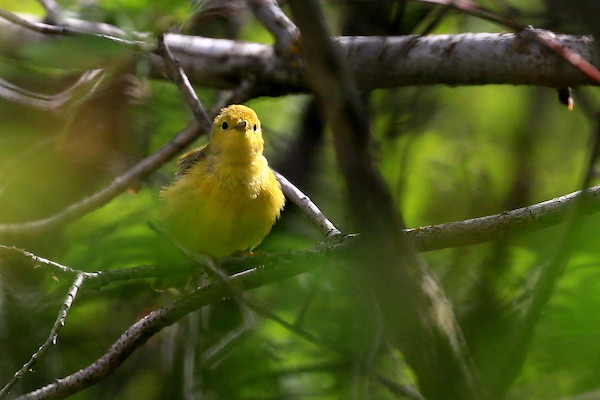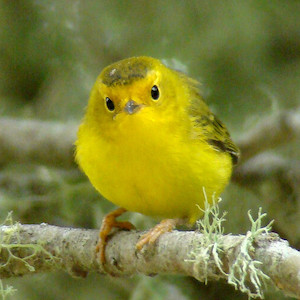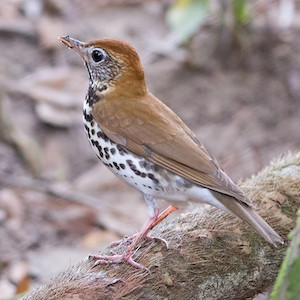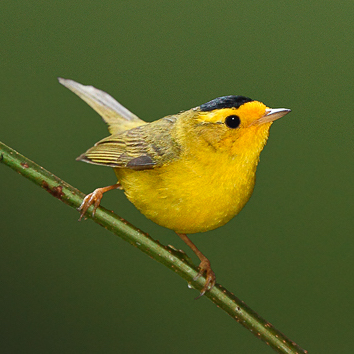Variety is not only the spice of life, it is also what species need to adapt to climate change. A species may evolve and adapt to a changing climate, but only if within the species there is enough variety in climate adapted traits for natural selection to act on.
Yellow Warblers know variety. The species breeds across a large swath of North America. In the spring you can hear them singing on the Alaskan tundra, on the brushy edges of Appalachian forests, and along rivers in Utah's red rock canyons. Warbler populations in each of these regions have adapted to very different temperatures and precipitation levels. These "local adaptations" add variety to the species. Yet yellow warblers spend most of their year on their non-breeding grounds in Central America and northern South America. How does having two homes affect their ability to adapt to local conditions? Do they find overwintering areas with climatic conditions that are similar to their breeding areas?
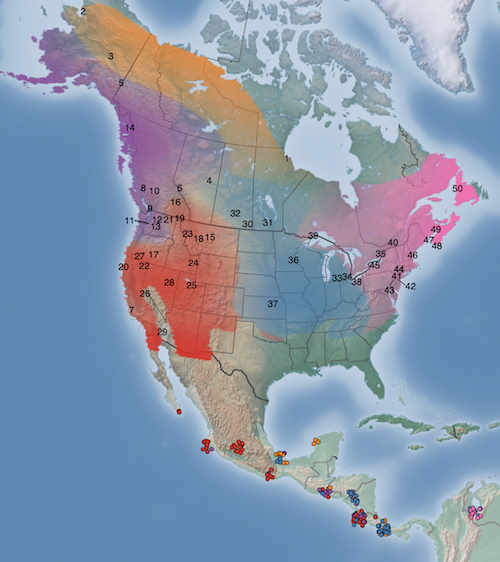
Figure 1 from Bay et al., 2021. Migratory connectivity in the Yellow Warbler. Different colors on the map of North American breeding range show the five breeding populations determined by genetic sequencing. Dots on wintering grounds indicate where wintering birds were sampled and dot color indicates which breeding population they belong to.
In a new study published in Ecology Letters, researchers led by Dr. Rachael Bay from the University of California Davis, and including scientists from IBP, University of Utah, University of Texas at Arlington, American Bird Conservancy, University of California Los Angeles, and Colorado State University investigated whether individual Yellow Warblers winter in areas with a climate similar to their breeding grounds. They used genetic data to link populations of Yellow Warblers breeding in different regions of North America with populations wintering in specific regions of Central and South America and compared the climate between the locations. (Some of this genetic data came from feather samples collected by MAPS and MoSI banders!) The researchers also looked at differences in the warblers physical characteristics across the breeding range and their relationship with different climatic variables. In addition, they used abundance data from the Breeding Bird Survey to examine how population sizes varied in response to climate over the past 50 years.
The researchers found that Yellow Warblers migrated between areas with similar amounts of monthly precipitation during the season that the birds occupied the area (i.e. spring and summer months in breeding areas and winter months in non-breeding areas.) However, the researchers did not find similarities in temperature between breeding and non-breeding areas used by the same populations.
Furthermore, the researchers found a correlation between bill size and precipitation. Yellow Warblers breeding in wetter regions tended to have longer, deeper bills. Studies in other bird species suggest that larger bills may help birds shed heat in warmer or more humid environments. Alternatively, differences in bill size may reflect local differences in food resources (insect types in the warbler's case.)
Finally, abundance estimates from the Breeding Bird Survey data showed that unusually high precipitation in the western, typically drier, parts of the Yellow Warbler's breeding range was associated with an increase in abundance in the following year or two. But in the eastern parts of the warbler's breeding range, unusually high precipitation was correlated with decreased abundance.
All of this adds up to a potential mechanism that may allow Yellow Warblers to maintain their local adaptations to different precipitation levels. Because birds that breed in wetter areas also winter in wetter areas, their adaptations to more precipitation are advantageous across their life cycle. If these same birds wintered in drier areas, those adaptations could be a disadvantage on the wintering grounds and individuals with these adaptations might get selected out of the population.
IBP research ecologist Jim Saracco, who co-authored this study, says it's not the first study to look at whether migratory birds winter and breed in areas with similar climates, a phenomenon referred to as "niche-tracking," but it may be the first to look at niche-tracking within a species. "This study is the first example (that I’m aware of) showing population-level niche tracking," says Saracco. "I think this is a potentially important mechanism for establishing and maintaining migratory connections between seasons." In other words, populations of warblers that are adapted to drier climates will migrate to drier areas of the non-breeding range and avoid wetter areas, which will reinforce the connection between a specific breeding population and a specific wintering area.
Saracco says that the positive correlations between precipitation and abundance of Yellow Warblers in water-limited regions of the west and negative correlations between abundance and precipitation in wetter regions of the east are particularly interesting. "Climate change is causing multi-year extreme climate conditions across the species’ range, for instance the recent droughts in the southwest US," says Saracco. "It seems that despite adaptation of local populations to average local climate conditions, climate change may be challenging the physiological limits of populations, or their ability to adapt quickly enough to these extremes. Recent declines observed across much of the Yellow Warbler range may already be a reflection of climate change."

Yellow Warbler. Photo by Rodney Campbell/Flickr.
While this study does not address conservation implications directly, Saracco says that it highlights the role that understanding migratory linkages can play in focusing conservation efforts. "For example, although we found some degree of breeding population mixing on wintering grounds, efforts to reverse population declines of northeastern breeding Yellow Warblers should consider potential stressors on this population's wintering grounds in northern South America," Saracco notes. "While similar efforts for west coast populations would more effectively focus efforts on wintering areas in western Mexico."
This study highlights once again the importance of studying and monitoring migratory bird populations across the annual cycle - which is a primary goal of the MAPS and MoSI programs. Banding and aging birds on both their breeding and wintering grounds not only provides an opportunity to collect genetic samples, like those used in this study, it also allows scientists to estimate survival and productivity, which are key metrics for conservation.


